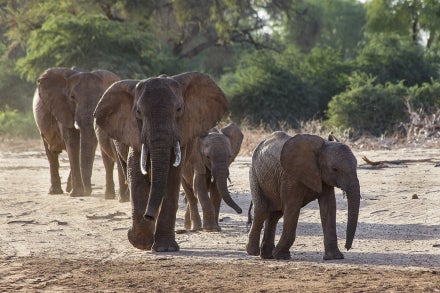Image

San Diego Zoo Welcomes First Mandrill Baby in 14 years
The San Diego Zoo’s mandrill group welcomed a new addition to their ranks this week. Female mandrill Kesi gave birth to a baby boy—the first mandrill born at the Zoo in over 14 years. Animal care staff had been watching for Kesi to give birth; but the night before, there were still no signs she was in labor. The next day, staff members said they were surprised to see Kesi walk out of her bedroom holding her new baby.
“It’s like every day we would come in in the morning and think like there might be a baby – we don’t know,” Jenny Baublit, senior primate keeper at the San Diego Zoo. “To actually see it was pretty incredible. Especially since she came in so quietly, just like a typical morning, but just happen to have a baby with her.”
 The species is listed as vulnerable on the International Union for Conservation of Nature (IUCN) Red List of Threatened Species, with their numbers decreasing because of habitat loss from illegal logging and the bushmeat trade (hunting wild species for food). This trade has become lucrative and, as human populations increase, it is becoming a greater threat to many species’ survival.
The San Diego Zoo's first mandrills, Peter and Suzy, arrived in 1923. More mandrills arrived in 1938, and a mandrill breeding program was established in an effort to bolster the population. More than 34 mandrills have been born at the Zoo and Safari Park over the years.
Guests can visit the Zoo’s three mandrills on Monkey Trail in Lost Forest. They share an exhibit with guenons, including spot-nosed monkeys and Wolf’s monkeys.
.
The species is listed as vulnerable on the International Union for Conservation of Nature (IUCN) Red List of Threatened Species, with their numbers decreasing because of habitat loss from illegal logging and the bushmeat trade (hunting wild species for food). This trade has become lucrative and, as human populations increase, it is becoming a greater threat to many species’ survival.
The San Diego Zoo's first mandrills, Peter and Suzy, arrived in 1923. More mandrills arrived in 1938, and a mandrill breeding program was established in an effort to bolster the population. More than 34 mandrills have been born at the Zoo and Safari Park over the years.
Guests can visit the Zoo’s three mandrills on Monkey Trail in Lost Forest. They share an exhibit with guenons, including spot-nosed monkeys and Wolf’s monkeys.
.
This is the first baby for Kesi and male mandrill Jasper. So far, staff said, they are doing exceptionally well as new parents—and mom is being very attentive to the baby’s nursing needs. Mandrills are the largest and most colorful of the Old World monkeys. They are easily recognizable by their furry head crests, manes and golden beards—and their bright coloration, with red nose and lips, and thick purple and blue ridges along the sides of the nose. Mandrills live in small social units in the rain forests of equatorial Africa. These small groups often join with others to form larger groups called hordes that can number in the hundreds, and sometimes have more than 1,000 members.A video posted by San Diego Zoo (@sandiegozoo) on Dec 2, 2016 at 4:47pm PST
 The species is listed as vulnerable on the International Union for Conservation of Nature (IUCN) Red List of Threatened Species, with their numbers decreasing because of habitat loss from illegal logging and the bushmeat trade (hunting wild species for food). This trade has become lucrative and, as human populations increase, it is becoming a greater threat to many species’ survival.
The San Diego Zoo's first mandrills, Peter and Suzy, arrived in 1923. More mandrills arrived in 1938, and a mandrill breeding program was established in an effort to bolster the population. More than 34 mandrills have been born at the Zoo and Safari Park over the years.
Guests can visit the Zoo’s three mandrills on Monkey Trail in Lost Forest. They share an exhibit with guenons, including spot-nosed monkeys and Wolf’s monkeys.
.
The species is listed as vulnerable on the International Union for Conservation of Nature (IUCN) Red List of Threatened Species, with their numbers decreasing because of habitat loss from illegal logging and the bushmeat trade (hunting wild species for food). This trade has become lucrative and, as human populations increase, it is becoming a greater threat to many species’ survival.
The San Diego Zoo's first mandrills, Peter and Suzy, arrived in 1923. More mandrills arrived in 1938, and a mandrill breeding program was established in an effort to bolster the population. More than 34 mandrills have been born at the Zoo and Safari Park over the years.
Guests can visit the Zoo’s three mandrills on Monkey Trail in Lost Forest. They share an exhibit with guenons, including spot-nosed monkeys and Wolf’s monkeys.
.



